The Harappan Civilization Chapter Notes | History Class 9 ICSE PDF Download
| Table of contents |

|
| Introduction |

|
| The Harappan Civilisation |

|
| Origin of the Civilisation |

|
| Urban Planning |

|
| Trade |

|
| Arts and Crafts |

|
| Religion |

|
| Decline of the Civilisation |

|
Introduction
Imagine stepping into a world over 5,000 years old, where cities thrived with remarkable planning, trade flourished across continents, and people crafted intricate seals and sculptures. The Harappan Civilisation, also known as the Indus Valley Civilisation, is a fascinating chapter of human history that unfolded along the banks of the River Indus. Discovered in the 1920s, this Bronze Age civilisation amazes us with its advanced urban systems, skilled craftsmanship, and mysterious script that remains undeciphered. These notes will guide you through its origins, achievements, and eventual decline, offering a glimpse into one of the world’s earliest urban societies.
Civilisation and Its Beginnings
- Civilisation represents an advanced stage of human cultural development.
- Between 4000 BC and 3000 BC, many civilisations emerged near river banks for access to water for drinking and irrigation.
- The discovery of metals marked a significant advancement in human progress.
- Copper was the first metal used by humans, leading to the Chalcolithic Period (4000 BC–3000 BC) when both stone and copper tools were used.
- Later, humans mixed copper with tin or zinc to create bronze, a harder alloy used for tools and weapons.
- Bronze Age civilisations, including Harappan, Mesopotamian, Chinese, and Egyptian, developed due to the use of bronze.
- Example: In the Chalcolithic Period, a farmer might use a copper axe to clear land, which was more efficient than a stone axe, improving agricultural productivity.
The Harappan Civilisation
- Named after Harappa, the first site unearthed in West Punjab, Pakistan.
- In 1862, Sir Alexander Cunningham noted the unique traits of Harappan cities.
- Cities were discovered during railway construction when bricks were collected.
- In 1921, Dayaram Sahni excavated Harappa, and R. D. Banerjee discovered Mohenjo-daro.
- Other key sites include Lothal, Dholavira, Surkotada (Gujarat), Kalibangan (Rajasthan), and Chanhudaro (Pakistan).
- Known as the Indus Valley Civilisation, it developed along the River Indus and its tributaries.
Sources
- Archaeological remains like seals, pottery, sculptures, and buildings provide insights into the Harappan Civilisation.
The Great Bath
- Found at Mohenjo-daro, it showcases advanced building skills.
- Likely used for religious bathing ceremonies.
- Suggests a hierarchical society where the ruling class collected taxes for public structures.
The Citadel
- Cities were divided into two parts: the elevated citadel and the lower town.
- The citadel housed important buildings like the Great Bath, granaries, assembly halls, and workshops.
- Indicates efficient urban planning, confirming the civilisation’s urban nature.
- Houses on elevated platforms suggest a division between ruling and ruled classes.
- The western part of the city was built on the higher platform called the citadel.
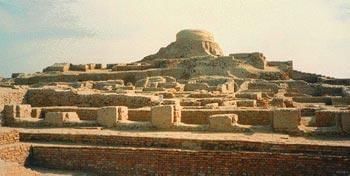
Seals
- Around 2,000 seals were found at Harappa and Mohenjo-daro, mostly rectangular or square.
- Featured images of a one-horned bull, goat, tiger, elephant, and rhinoceros.
- Provide insights into trade, religious beliefs, and script.
- A seal with a Pashupati image suggests belief in Lord Shiva.
- Harappan seals found in Mesopotamia indicate trade with other civilisations.
Bearded Man and Dancing Girl
- A sculpture of a bearded man from Mohenjo-daro, with a shawl over his left shoulder and half-closed eyes, is considered a yogi.
- Shows the presence of skilled artisans.

- The bronze dancing girl sculpture also highlights advanced craftsmanship.
Cemeteries
- Found at Lothal, Kalibangan, and Rupar, they reveal religious rituals and beliefs.
- Burials with goods like animals, copper, and shell spoons suggest belief in an afterlife.
Dockyard
- A rectangular dockyard at Lothal, Gujarat, indicates maritime trade with other civilisations.
Script
- The Harappans used a pictographic script with 375–400 signs depicting birds, animals, fish, and human forms.
- The script remains undeciphered.
Origin of the Civilisation
- Some scholars believe the civilisation arose due to sudden migration into the Indus basin.
- Others argue it was not indigenous but an extension of local villages, supported by recent research.
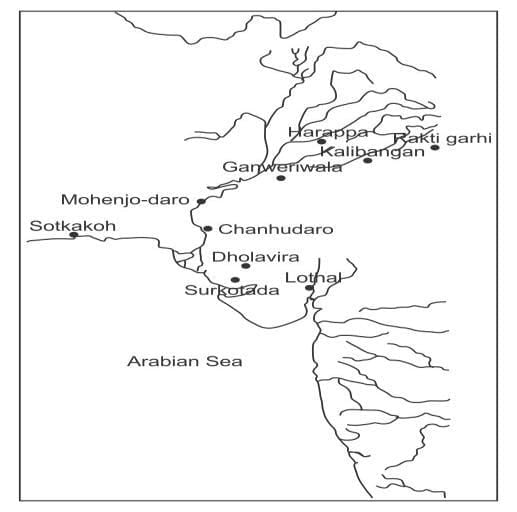
Extent of the Civilisation
- Covered parts of Punjab, Haryana, Sindh, Baluchistan, Gujarat, Rajasthan, and Western Uttar Pradesh.
- After Partition, Harappa, Mohenjo-daro, Chanhudaro, and Sutkagendor are in Pakistan.
- Manda, Banawali, Kalibangan, Alamgirpur, Lothal, Rupar, and Rangpur are in India.
Urban Planning
The Harappan Civilisation is renowned for its advanced urban planning.
Town Planning
- Cities were divided into a citadel (elevated area) and a lower town, separated by a wall.
- The citadel contained key buildings like the Great Bath, granary, and assembly hall.
- Roads were straight, intersecting at right angles; the main road in Mohenjo-daro was 10.5 meters wide and 800 meters long.
- The drainage system was well-developed with straight drains, gentle slopes, and covered drains with inspection holes for cleaning.
- Drains from houses connected to larger street drains.
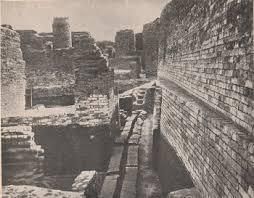
Houses
- Built on high mounds to prevent flooding.
- Had covered drains linked to street drains.
- Were one or two storeys, with rooms around a central courtyard.
- Included separate bathing areas; some had wells.
- Doors and windows opened onto side streets, not main roads, and had ventilators.
Monumental Architecture
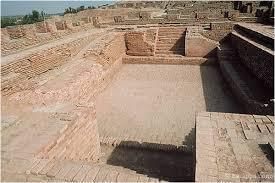
The Great Bath
- A major public building in Mohenjo-daro, measuring 39 feet long, 28 feet wide, and 8 feet deep.
- Made of brick, coated with plaster and natural tar to prevent water leakage.
- Had steps on both sides and was surrounded by rooms, possibly for priests or changing clothes.
Granaries
- Found at Harappa, Lothal, and Mohenjo-daro; the Mohenjo-daro granary was 45.71 meters long and 15.23 meters wide.
- Harappa had two rows of six granaries with circular brick platforms for threshing grains, as wheat and barley remains were found.
- Two-roomed barracks near granaries likely housed laborers.
- Built on raised platforms to protect against floods.
Trade
- The Harappans traded with many Asian countries, using stone, metal, and shell within the civilisation.
- Barter trade was common.
- Harappa, Mohenjo-daro, and Lothal produced tools, weapons, and kitchenware.
- Rice was likely imported from Gujarat to Punjab.
- Bangle-making centers included Harappa, Mohenjo-daro, Banawali, and Balakot.
- Bead-making was prominent in Lothal and Chanhudaro.
- Lothal, Surkotada, and Balakot traded with Mesopotamia and West Asia.
- A trading colony in northern Afghanistan facilitated trade with Central Asia.
- Imported gold from North Karnataka and Afghanistan, and copper from Rajasthan, South India, Baluchistan, and Arabia.
- A dockyard at Lothal confirms maritime trade.
Weights and Measures
- Cubical stone weights were used, with the basic unit being 16 (equivalent to 14 grams today).
- Larger weights were multiples of 16 (e.g., 32, 48, 64), and smaller ones were fractions of 16.
Transport
- Boats and ships transported goods from production centers to cities.
- Bullock carts were used for travel within cities.
Arts and Crafts
- Clay and terracotta figurines like bullock carts and ploughs were common.
- Beads, weights, and blades were crafted.
- Copper and bronze were used for tools, weapons, and vessels; gold and silver for ornaments.
- Pottery was glossy, decorated with black geometrical designs, showcasing skilled craftsmanship.
Sculpture
- Harappan artists created stone images, including a yogi with a shawl over his left arm.
- The bronze dancing girl statue is a notable artwork.
- Bronze animal figures like buffalo and carts were made using the lost wax process.
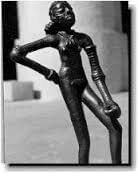
- In the lost wax process, wax figures were coated with clay, heated to remove wax, and filled with molten metal.
- Example: To create a bronze buffalo statue, artisans shaped wax into a buffalo, covered it with clay, heated it to melt the wax, and poured molten bronze into the mold, resulting in a detailed statue.
Ornaments
- Included necklaces, finger rings, bangles, armlets, anklets, nose rings, and earrings made of gold, silver, precious stones, and ivory.
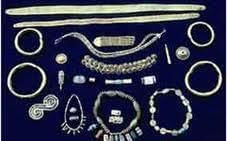
Toys and Amusements
- Toys included birds, animal figurines, carts, and whistles.
- Musical instruments like drums and lyres were used.
- People likely played dice and engaged in hunting and fishing.
- Beads made of stone and metal were found.
Religion
- Seals provide key information about Harappan religious practices.
- No temples or cult objects were found, except a fire altar at Kalibangan.
- Seals with Pashupati, goddesses, sacred trees, and animals suggest connections to later Hinduism.
- A figure of a plant growing from a woman’s body indicates worship of Mother Earth, also seen in the Middle East and Europe.
- Sacred animals included bulls, humped bulls, elephants, and tigers.
- Numerous amulets suggest belief in evil forces.
Decline of the Civilisation
The civilisation declined around 1800 BC due to several factors.
Climatic Changes and Floods
- Rainfall increased around 3000 BC but later decreased, affecting agriculture and animal breeding.
- Soil fertility declined due to increased salinity, leading to desertification.
- Changes in river courses may have caused devastating floods.
Deforestation
- Large-scale use of wood for bronze production, pottery, boats, furniture, and jewelry led to deforestation.
- Deforestation caused climatic changes in the region.
Earthquake
- Earthquakes may have altered the River Indus’s course, flooding Mohenjo-daro’s interior areas.
Attack of the Aryans
- Historians like Mortimer Wheeler suggest Aryans from Central Asia invaded and destroyed Indus settlements.
- Skeletons of men, women, and children found in Mohenjo-daro streets and rooms indicate violent deaths.
- In the final phase, 13 skeletons (males, females, and one child) were found in a room, supporting the invasion theory.
|
14 videos|59 docs|16 tests
|
FAQs on The Harappan Civilization Chapter Notes - History Class 9 ICSE
| 1. What were the key features of urban planning in the Harappan Civilisation? |  |
| 2. What role did trade play in the Harappan Civilisation? |  |
| 3. What were the primary forms of art and craft during the Harappan Civilisation? |  |
| 4. What evidence do we have about the religious beliefs of the Harappan people? |  |
| 5. What are the theories regarding the decline of the Harappan Civilisation? |  |




















